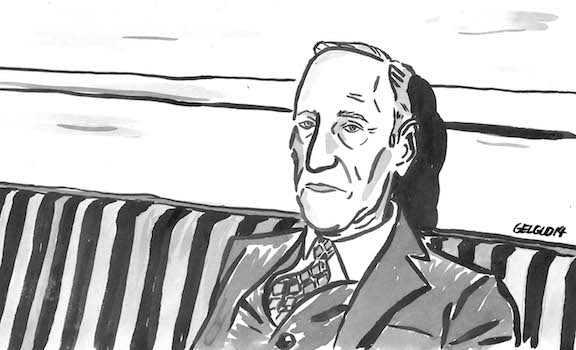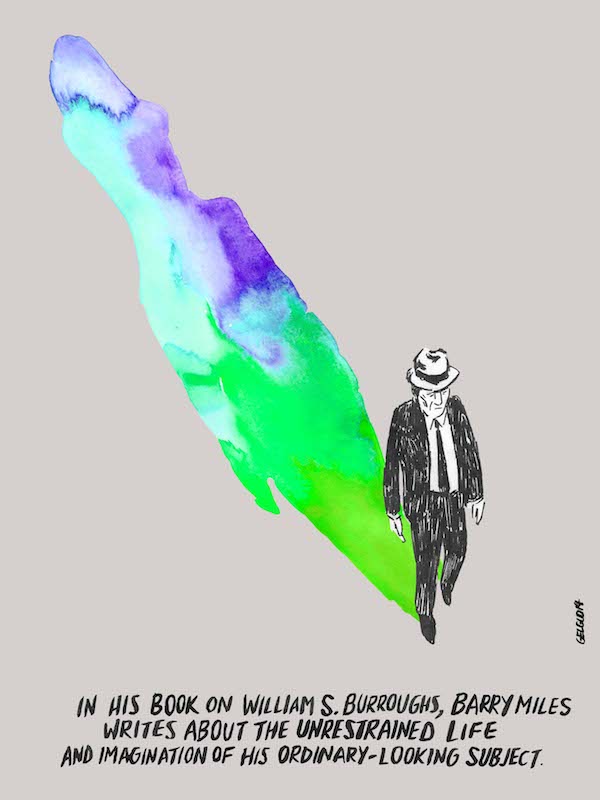Incognito and Daring: Beat Biographer Barry Miles on William S. Burroughs
By Nathan Gelgud

Nathan Gelgud illustration inspired by Call Me Burroughs, a new biography by Barry Miles.
William S. Burroughs was a writer of daring experimentation, outlandish story lines, and such degenerate subject matter that it could even make a guy like his pal Allen Ginsberg think he was taking things too far. He also had a seemingly incongruous lifelong interest in cultivating anonymity, preferring to blend in wherever he could in favor of blazing a bright trail the way that some of his friends and contemporaries were known for doing.
The contrast and connection between Burroughs's desire for invisibility and his transgressive art-making is one of many through-lines of Barry Miles's exquisite new biography of the author of Naked Lunch. Over the past couple decades, Miles has earned a position as the unofficial historian of the Beat Generation, and is the author of a previous book about Burroughs William Burroughs: El Hombre Invisible, as well as The Beat Hotel, Jack Kerouac: King of the Beats, and Allen Ginsberg: Beat Poet.
In this rare breed of biography, the chapters on childhood in Miles's latest, Call Me Burroughs, are not just throat-clearing preamble to set up context for the good stuff, the part where the subject does whatever earns him his legacy. Miles helps depict Burroughs’s early life as strange and complex, filled with disturbing episodes that feel shocking and exciting, evoking the weird dream that childhood looks like in retrospect.
When Burroughs grows up and starts running with Jack Kerouac and Allen Ginsberg (who says upon their meeting that Burroughs looks “like a shy bank clerk”), we're treated to stories we've read before, maybe even in one of Miles's previous books. But here it feels crisp and electric, the way the friends pass in and out of each other's apartments, slinking through bars and running around the streets of New York City. This is when Burroughs meets Joan Vollmer, an eccentric young woman with whom he'd spend the next half-decade, before accidentally killing her in a drunken party stunt.
The memory of the incident would haunt Burroughs for the rest of his life, contributing to his numerous substance addictions and a desire to disappear into his surroundings -- a kind of ersatz suicide as penance for the awful accident. Burroughs's 1959 embrace of Brion Gysin's cut-up technique, the act of physically cutting pages of pre-existing text and pasting them together arbitrarily to find new phrases and sentences, may even be read as an attempt at artistic anonymity, or a desire to take himself out of his very own writing.
Later, filmmaker Nicolas Roeg would use the inspiration of the cut-up technique when making Performance (with Mick Jagger), and David Bowie used cut-ups to write lyrics for some his best albums. They're hardly alone in having been influenced by Burroughs. It's impossible to imagine what the past half-century of anything related to counter-cultures or the artistic underground would look like if not for Burroughs. In his book, Miles brings the story behind this would-be invisible man into sharp focus, doing his subject justice and giving readers the great gift of a clear look at an important artist.

Nathan Gelgud illustration inspired by Call Me Burroughs, a new biography by Barry Miles.
